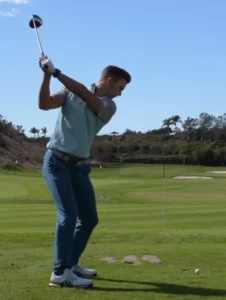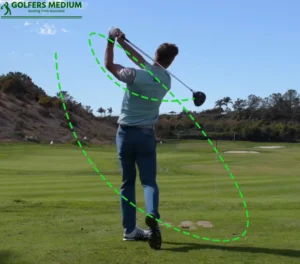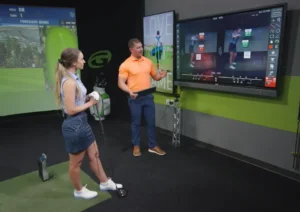Golf is a game of precision and skill, and at the heart of every successful golf shot lies a solid golf swing.
Mastering the basic fundamentals of the golf swing is essential for consistency, accuracy, and overall improvement. In this comprehensive guide, we will dive deep into the essential tips and techniques that will help you develop a reliable and effective golf swing.
Whether you’re a beginner or looking to refine your skills, this comprehensive guide will provide you with the essential knowledge and techniques to develop a solid foundation for your golf swing.
Here are the 5 swing tips:
1. Understanding the Fundamentals
The Grip: Laying the Foundation

One of the most fundamental aspects of a successful golf swing is a proper grip. Your grip influences the control, power, and feel of your shots. To achieve a solid grip, start by placing your lead hand (left hand for right-handed golfers) on the club, positioning the grip diagonally across your fingers. Then, place your trailing hand (right hand for right-handed golfers) below the lead hand, with the grip resting diagonally across the fingers. Maintain a neutral grip pressure, ensuring neither too tight nor too loose of a grip.
Stance and Alignment: Setting Up for Success

Your stance and alignment play a crucial role in the consistency and accuracy of your swing. Start by positioning your feet shoulder-width apart, with the ball aligned with the inside of your leading foot. Distribute your weight evenly on the balls of both feet, maintaining a slight flex in your knees. Align your body parallel to the target line, aiming the clubface at the target. This proper setup will lay the foundation for a more effective and repeatable swing.
Posture and Balance: Building a Solid Foundation
Maintaining proper posture and balance throughout the swing is vital for optimal ball striking. Start by standing tall with your spine straight, and tilt forward from your hips. Maintain a slight bend in your knees, allowing your arms to hang naturally. Ensure your weight is centered and balanced over the arches of your feet, avoiding excessive weight on the toes or heels. This balanced posture will help you maintain stability and generate power during the swing.
2. Mastering the Backswing

The Takeaway: Starting on the Right Path
The takeaway sets the stage for a smooth backswing. Begin by initiating the movement with your shoulders, allowing your arms and hands to follow naturally. Keep the clubhead low to the ground during the takeaway, ensuring a wide arc and avoiding any excessive wrist movement. This controlled and synchronized motion will position you for a well-executed backswing.
Rotation and Coiling: Generating Power
To generate power in your swing, focus on maximizing the rotation and coiling of your body during the backswing. Turn your shoulders away from the target while maintaining a stable lower body. Allow your hips to rotate naturally, creating torque and storing energy to be unleashed during the downswing. The proper rotation and coiling will help you generate more clubhead speed and distance.
Tempo and Timing: The Rhythm of Success

The tempo and timing of your backswing are critical for consistency. Maintain a smooth and rhythmic pace, avoiding any sudden or jerky movements. The backswing should be in sync with the rest of your body, ensuring a fluid and coordinated swing. Practice finding the right tempo that suits your swing style and helps you maintain control throughout the entire motion.
3. Nailing the Downswing
Transition and Weight Shift: Initiating the Downswing
The transition from backswing to downswing is a crucial moment that requires proper weight shift and timing. Initiate the downswing by shifting your weight onto your leading foot, transferring power from your back leg to your front leg. This weight shift should be initiated with a subtle lateral movement of the hips, followed by the rotation of the lower body. A well-executed transition sets the stage for a powerful downswing.
Lag and Release: Unleashing Power and Accuracy
Maintaining lag in the downswing is essential for generating maximum power and accuracy. Lag refers to the angle formed between the club shaft and your lead arm during the downswing. To create and preserve lag, start the downswing with your lower body while maintaining the angle between your lead arm and the club shaft. Release the club at the last moment, delivering a crisp and powerful strike to the ball.
Impact and Follow-Through: Making Solid Contact
The moment of impact and the follow-through are critical for consistent ball striking. Focus on striking the ball with a square clubface, ensuring the clubhead meets the ball at the right moment. Maintain a firm and controlled wrist position through impact, avoiding any flipping or scooping motion. A balanced and extended follow-through will complete the swing and provide feedback on the quality of the strike.
4. Troubleshooting Common Swing Errors
Slicing: Causes and Fixes
Slicing can be a frustrating and common issue for many golfers. It occurs when the ball curves sharply from left to right (for right-handed golfers). Slicing is often caused by an open clubface at impact or an out-to-in swing path. To fix slicing, focus on squaring the clubface at impact and correcting your swing path. Drills and exercises, such as the towel drill or alignment sticks, can help you develop a more inside-out swing path and reduce slicing.
Hooking: Causes and Fixes
A hook is the opposite of a slice, with the ball curving sharply from right to left (for right-handed golfers). It is typically caused by a closed clubface or an in-to-out swing path. To correct a hook, work on squaring the clubface at impact and adjusting your swing path. Practice drills, such as hitting fade shots or using an alignment stick, can help you develop a more square clubface and promote a straighter ball flight.
Topping and Fat Shots: Causes and Fixes
Topping the ball or hitting fat shots can lead to inconsistent ball striking and loss of distance. Topping occurs when the club strikes the upper half of the ball, resulting in a low and weak shot. Fat shots happen when the club strikes the ground before contacting the ball. These issues can be caused by poor posture, incorrect ball position, or improper weight distribution. To overcome topping and fat shots, focus on maintaining a balanced posture, positioning the ball correctly, and ensuring a proper weight transfer during the swing.
5. Practicing with Purpose
Developing a Practice Routine
Effective practice is the key to improvement in golf. Develop a structured practice routine that targets specific aspects of your swing and helps you refine your skills. Dedicate time to each element of the swing, including the grip, setup, backswing, downswing, and short game. Incorporate drills, repetition, and feedback to make your practice sessions purposeful and productive.
Utilizing Training Aids and Technology

Leveraging training aids and technology can significantly enhance your practice sessions. Various tools, such as alignment sticks, swing trainers, and impact bags, can provide instant feedback and help you develop proper swing mechanics. Additionally, video analysis and launch monitors can offer valuable insights into your swing, allowing you to identify areas for improvement and track your progress.
On-Course Strategies for Integration
Transferring your improved swing from the practice range to the course can be a challenge. Develop strategies to integrate your improved swing into real playing conditions. Gradually introduce your changes during practice rounds, focus on specific aspects of your swing during regular play, and embrace the process of adapting your swing on the course. With time and practice, your improved swing will become second nature during competitive rounds.
Conclusion: Building a Solid Foundation for Your Golf Swing
Congratulations! By mastering these golf swing technique, you will laid a solid foundation for your journey as a golfer. Remember that consistency and practice are key to refining your skills further. Embrace the process, enjoy the game, and watch your golf swing reach new heights.
FAQs
Q1: How long does it take to master the golf swing?
Ans: Mastering the golf swing is a continual process that varies from individual to individual. While some may see improvements in a relatively short period, it generally takes consistent practice and dedication over several months or even years to achieve a highly refined and consistent swing.
Q2: Can I learn the golf swing without taking lessons?
Ans: While it’s possible to learn the golf swing through self-study and practice, taking lessons from a golf professional can greatly expedite your progress. A professional instructor can provide personalized guidance, identify specific areas for improvement, and help you develop proper swing mechanics right from the start.
Q3: How often should I practice my golf swing?
Ans: The frequency of practice depends on your commitment level and schedule. Aim to practice your swing at least two to three times a week, dedicating focused sessions to different aspects of the swing. Regular practice and repetition are key to building muscle memory and developing a consistent swing.
Q4: Are there any exercises or drills to improve my golf swing at home?
Ans: Yes, there are several exercises and drills that can be done at home to improve your golf swing. These include practicing your grip, working on rotational flexibility, performing mirror drills to observe your swing mechanics, and using impact bags or swing trainers. However, it’s important to consult with a golf professional to ensure you’re performing the exercises and drills correctly to avoid any potential injury.
Q5: How can I maintain my swing consistency during a round of golf?
Ans: Maintaining swing consistency during a round of golf requires mental focus and adherence to the fundamentals. Avoid overthinking your swing mechanics during the round and trust in the work you’ve put in during practice. Stick to your pre-shot routine, maintain a calm and positive mindset, and focus on the target rather than any swing-related thoughts. Remember, consistency comes with experience and practice.
Q6: Should I make changes to my swing during the golf season?
Ans: Making significant changes to your swing during the golf season can be challenging and may initially lead to a decline in performance. It’s generally recommended to work on swing changes during the offseason or during practice sessions, gradually integrating them into your game over time. However, minor adjustments or refinements to specific elements of your swing can be made during the season with the guidance of a golf professional.
Q7: How can I fix a persistent slice or hook in my swing?
Ans: A persistent slice or hook can be corrected through a combination of adjustments to your swing mechanics and understanding the root causes. Consult with a golf professional to diagnose the specific issues in your swing and receive tailored drills and exercises to correct them. Practice maintaining a square clubface at impact, working on swing path adjustments, and gradually ingraining the changes through focused repetition.
Q8: How long does it take to see improvement in my golf swing?
Ans: The time it takes to see improvement in your golf swing varies based on individual factors such as natural ability, commitment to practice, and the frequency of play. With dedicated practice and proper guidance, noticeable improvements can be seen within a few weeks to a few months. However, continuous practice and refinement are necessary for ongoing improvement and to maintain a consistent and effective swing.
Hi! I am Hannah, a golf enthusiast, have been perfecting my swing for over a decade, making long putts a breeze. Aside from playing, I am a professional golf writer, I try capture the nuances of the game and inspire others to embrace their love for golf. Follow me on Twitter.

